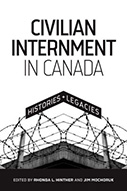Civilian Internment In Canada: Histories And Legacies

Editors: Rhonda L. Hiinther and Jam Mochoruk
Publisher: Winnipeg, Canada: University of Manitoba Press, 2020. 424p.
Reviewers: Britta Crandall and Russell Crandall | February 2021
Young Canadian Myron Shatulsky, age 11, had the worst of luck when the train transferring his interned father, Matthew Shatulsky, departed two hours early on a journey from Kananaskis, Alberta to Petawawa, Ontario. The time was July 1941 when Canada was already fighting in World War II. Myron had not laid eyes on his father in over a year since his detainment by the Royal Canadian Mounted Police (RCMP) – part of Ottawa’s “official repression of communism” as described by one historian. (1). As co-editors and historians Rhonda L. Hinther and Jim Mochoruk write in the introduction to the unorthodox and emotional collection of essays, Civilian Internment in Canada, these sorts of micro episodes of internment invariably led to painful outcomes. In the case of the Shatulkskys, wife Katherine wrote a letter to her detained spouse explaining their son’s pain when he was unable to see his father passing through. “The poor boy has so many scars on his heart to heal that he will remember for the rest of his life.” (1) And indeed Myron, now in his 80s, still feels this anguish.
Hinther and Mochoruk believe this searing tale – in addition to others – serve as a “powerful reminder” of the “fragility of civil liberties and human rights,” as well as a stand-in for a larger, more contested discussion on internment over the span of Canada’s history. Internment affected a wide range of political, social, and ethnic backgrounds during “times of war and perceived war” for Canada, the most infamous being the internment of citizens of Japanese, Ukrainian and Italian descent. The editors very much want readers to understand that Canada, despite all of the adulation it often receives in global diplomatic circles these days, had a “rich and shameful” record on these very civil right and liberties via civilian internment—defined as the detention as a prisoner without formal charge and conviction, almost always for political or military reasons.
And the numbers are astounding. Close to 6,000 Eastern Europeans—mostly from the Austro-Hungarian empire, were rounded up for putative violations of national security during World War I. Another 80,000 were required to register and meet regularly with regional and local authorities. How could Ottawa do this? Easily, we learn, as the War Measures Act gave the state the broad power to hold and imprison “dangerous foreigners.” For the editors, this intentionally dubious and vague rationale provided additional cover for the state’s anxiety about those it “disliked or feared.” During World War II, the Canadian state used another mechanism, the Defence of Canada Regulations, to target Japanese Canadians, eventually “evacuating” 20,000 from the West Coast to putatively more secure locations. The editors are convinced that this was more smoke to cover what is so often “racist targeting” of ethnic groups. Later on during the Cold War, the editors contend that Canadian officials picked up hundreds of leftists and fellow travelers who were in fact neither communists nor terrorists, but rather “political critics of the dominant order in Quebec and Canada.” (4)
The intentional broad, inter-disciplinary roster of contributors includes everything from conventional historians to community activists to memoirists who survived internment. Taking together, these voices serve as a sobering reminder about not being complacent about the norms undergirding democracies.
Russell Crandall is a professor in the Political Science Department at Davidson College
Britta Crandall is a Visiting Assistant Professor of Latin American Studies at Davidson College


